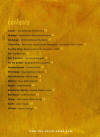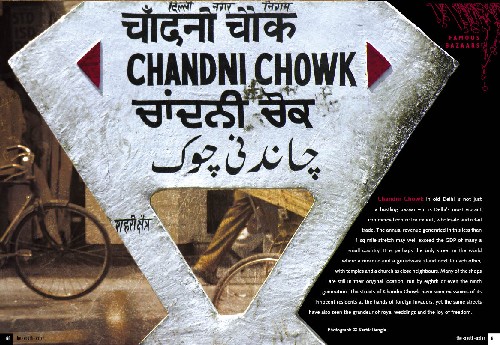|
|
the-south-asian.com August 2007 |
|
|||
|
Famous
Bazaars
Ratan Tata
Remaining
articles
Books Between
Heaven and Hell
|
|
||||
|
Page
1 of 3 Chandni Chowk – South Asia’s oldest bazaar All photographs and text copyright: The South Asian Media & Publishing
Chandni Chowk in old Delhi is not just a bustling bazaar – it is Delhi’s most vibrant commercial centre for export, wholesale and retail trade. The annual revenue generated in this less than 1 sq mile stretch may well exceed the GDP of many a small country. It is perhaps the only street in the world where a mosque and a gurudwara stand next to each other, with temples and a church as close neighbours. Many of the shops are still in their original location, run by eighth or even the ninth generation. The streets of Chandni Chowk have seen massacres of its innocent residents at the hands of foreign invaders, yet the same streets have also seen the grandeur of royal weddings and the joy of freedom.
An inscription on one of the walls at Diwan – I – Khas in the Red Fort describes Delhi as "If on earth there be a place of bliss It is this, it is this, it is this" Mir Taqi Mir, a poet from Delhi, wrote: "The streets of Delhi are not mere streets; They are like the album of a painter" Old Delhi, or Shahjahanabad as it was named by the Mughal Emperor Shahjahan, has a history of resilience – plundered, looted and destroyed several times over by central Asian and Persian rulers – the city always returned to its cultural sophistication, intellectual sensitivity and commercial buoyancy – a tribute to the undying spirit of the citizens of Delhi. Chandni Chowk in old Delhi is not just a bustling bazaar – it is Delhi’s most vibrant commercial centre for export, wholesale and retail trade. The annual revenue generated in this less than 1 sq mile stretch may well exceed the GDP of many a small country. The broad spectrum of trade goods lend it colour and ‘spice’, while the co-existence of temples, mosques, church and gurudwara define its truly secular character. Its street food is still prepared and fed with love and pride, and the better-known family-run shops, some of them over two hundred years old, have lived through history. They have seen grand royal celebrations and weddings, and also lived through brutal massacres. It is a world unto itself – an organic entity – self-sufficient and proud. Its by-lanes are warrens of specialised trade, accessible, in places, only on foot. Chandni Chowk – or the ‘Moonlit Square’ was once an aesthetically planned bazaar, the talk of the town for its beautiful layouts – supposedly the brainchild of Roshanara, the daughter of the Master Builder Emperor Shahjahan, who is known the world over for building the Taj Mahal. Built over 350 years ago, the eastern end of the bazaar faces the Red Fort, the imposing purpose-built palace of Emperor Shahjahan, who moved there in 1640. The Chandni Chowk of yore had a tree-lined canal running through it – a challenge to one’s imagination when one experiences its present day demographic chaos. The covered shops on either side of the canal were exotic little boutiques selling the rarest of pearls and gems, brocades and silks, exotic ‘attars’, and everything to kindle and entice the desire and purses of the ladies of the royal household just across the road and wives of the richer folks in the city of Shahjahanabad – as Delhi was then known. The exclusivity and the quality of wares would have made New York’s Fifth Avenue highly insecure. Today’s Chandni Chowk is a different story. The canal was
closed and sealed by the British. Instead, there is a gushing river of
humanity on foot and rickshaws, the momentum and density of which increases
with the day. The house facades along the main bazaar, many covered with
billboards, are not exactly on top of the residents’ or the municipality’s
agenda. Major banks that occupy some of the heritage buildings have shown
little respect and done little towards the upkeep or conservation of the
heritage gems they occupy. Overall, the general look is one of shabbiness –
electrical wiring criss-crossing the rooftops, hanging balustrades, peeling
paint, crumbling walls – nothing about the appearance of the bazaar is
reminiscent of its glorious past.
|
|||||
|
Copyright © 2000 - 2007 [the-south-asian.com]. Intellectual Property. All rights reserved. |
|||||






